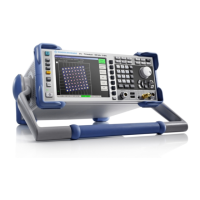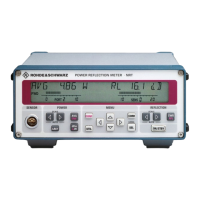Setting the Bandwidths R&S FSH
1309.6275.12 4.12 E-2
Setting the Bandwidths
A key feature of a spectrum analyzer is that it can display the frequency spectrum of a signal. The
resolution bandwidth determines how well a spectrum analyzer can separate adjacent frequencies.
Spectrum analyzers usually also have switchable video bandwidths. The video bandwidth is determined
by the cutoff frequency of the lowpass used to filter the video voltage before it is displayed. The video
voltage is the spectrum analyzer term for the voltage produced when the IF signal which has been
band-limited by the resolution filter is envelope detected. The video voltage is smoothed by video
filtering to, say, reduce noise on the trace. Unlike the resolution bandwidth, the video bandwidth has no
effect on the resolving power of the spectrum analyzer.
Resolution bandwidth
The resolution bandwidth (RES BW) of a spectrum analyzer determines the frequency resolution of
spectrum measurements. A sine signal is displayed on the screen "through" the passband of the
selected resolution filter. Therefore, a suitably small resolution bandwidth is required if two or more
signals whose frequencies are close together are to be displayed separately. The frequency difference
between two sinusoidal carriers, for example, cannot be less than the selected resolution bandwidth if
the carriers are to be resolved. Which resolution bandwidth is selected also has an effect on the noise
displayed by the spectrum analyzer. If the bandwidth is small, the noise displayed drops. If the
bandwidth is reduced or increased by a factor of 3, the noise displayed drops or goes up by 5 dB. If the
bandwidth is changed by a factor of 10, the displayed noise changes by 10 dB. Which resolution
bandwidth is selected also has an effect on the sweep speed. If the true spectrum is to be displayed,
the bandfilters that determine the resolution bandwidth must settle at all frequencies of interest. Narrow
bandfilters take longer to settle than wide filters. This is why a longer sweep time must be selected for
narrow resolution bandwidths. If the bandwidth is reduced by a factor of 3 (e.g. from 10 kHz to 3 kHz),
the sweep time must be increased by a factor of 9. If the reduction factor is 10 (e.g. from 10 kHz to
1 kHz) the sweep time must be increased by a factor of 100.
The R&S FSH has resolution bandwidths from 100 Hz to 3 MHz in a 1, 3, 10 sequence. When the
default setting is selected, they are coupled to the span, i.e. if the span is reduced, a smaller resolution
bandwidth is automatically set. This means that in many cases the resolution bandwidth does not have
to be set separately – a higher frequency resolution is automatically set when the span is reduced.
All models offer a 200 kHz resolution bandwidth in addition. This bandwidth has to be selected
manually, i.e. it will not be activated automatically in the AUTO RES BW mode (resolution bandwidth
coupled to span).
Operating sequence:
Press the BW key.
The menu for setting the bandwidth opens. If the
default setting is activated, the softkey label for
automatically setting the bandwidth is highlighted in
green.
Press the MANUAL RES BW softkey
The softkey label is highlighted in red and the value
entry box for the resolution bandwidth (RBW) indicates
the current bandwidth. To indicate that the resolution
bandwidth is not coupled to the span, a small red circle
is placed before the resolution bandwidth display on
the screen.

